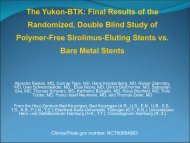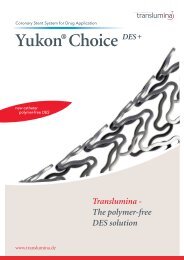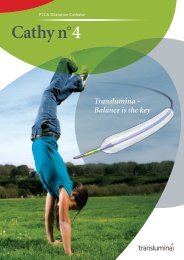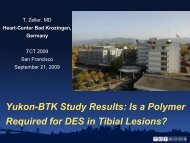PDF download - Translumina
PDF download - Translumina
PDF download - Translumina
Create successful ePaper yourself
Turn your PDF publications into a flip-book with our unique Google optimized e-Paper software.
Journal of the American College of Cardiology Vol. 49, No. 12, 2007<br />
© 2007 by the American College of Cardiology Foundation ISSN 0735-1097/07/$32.00<br />
Published by Elsevier Inc. doi:10.1016/j.jacc.2007.02.021<br />
LATE-BREAKING CLINICAL TRIALS<br />
Does Addition of Estradiol Improve<br />
the Efficacy of a Rapamycin-Eluting Stent?<br />
Results of the ISAR-PEACE Randomized Trial<br />
Tom Adriaenssens, MD, Julinda Mehilli, MD, Rainer Wessely, MD, Gjin Ndrepepa, MD,<br />
Melchior Seyfarth, MD, Anna Wieczorek, Birgit Blaich, PHD, Raisuke Iijima, MD, Jürgen Pache, MD,<br />
Adnan Kastrati, MD, Albert Schömig, MD<br />
Munich, Germany<br />
Objectives This study aimed to assess the efficacy of a rapamycin plus 17-�-estradiol–eluting stent versus a rapamycineluting<br />
stent in patients with coronary artery disease.<br />
Background Estradiol promotes rapid re-endothelialization of coronary stents in animal models, but it is not known whether<br />
combining this drug with rapamycin represents an improved drug-eluting stent technology in terms of reduced<br />
lumen renarrowing.<br />
Methods In this randomized study, we enrolled 502 patients with de novo lesions in native coronary arteries who were<br />
randomly assigned to receive either a polymer-free, estradiol plus rapamycin-eluting stent (ERES) (n � 252) or a<br />
polymer-free, rapamycin-eluting stent (RES) (n � 250). The primary end point was in-stent late lumen loss in the<br />
follow-up angiography. Secondary end points were binary angiographic restenosis, target lesion revascularization,<br />
combined incidence of death and myocardial infarction, and incidence of stent thrombosis during 1 year<br />
after randomization. The study was designed to test for the superiority of the ERES compared with the RES with<br />
respect to in-stent late lumen loss.<br />
Results Late lumen loss (0.52 � 0.58 mm vs. 0.51 � 0.58 mm, p � 0.83), the incidence of binary angiographic restenosis<br />
(17.6% vs. 16.9%, p � 0.85), the incidence of target lesion revascularization (14.3% vs. 13.2%, p � 0.72),<br />
the combined incidence of death and myocardial infarction (7.9% vs. 8.0%, p � 0.98), and the incidence of<br />
stent thrombosis (0.8% vs. 1.2%, p � 0.99) were not significantly different between the ERES group and the RES<br />
group.<br />
Conclusions No apparent beneficial effect is obtained by adding estradiol to a polymer-free rapamycin-eluting stent during<br />
the first year after the procedure. (The ISAR-PEACE trial; http://clinicaltrials.gov/ct/show/NCT00402636?<br />
order�1; NCT00402636) (J Am Coll Cardiol 2007;49:1265–71) © 2007 by the American College of Cardiology<br />
Foundation<br />
The use of drug-eluting stents (DES) has reduced the need<br />
for reintervention compared with bare-metal stents (BMS)<br />
(1). Despite these results, there is an intense ongoing debate<br />
on an increased risk of late stent thrombosis, particularly<br />
after discontinuation of thienopyridine therapy, and delayed<br />
onset of restenosis, or catch-up phenomenon, with DES<br />
(2–4). Lack of or delayed endothelialization associated with<br />
DES is considered an important factor that may precipitate<br />
From the Deutsches Herzzentrum, Technische Universtität, Munich, Germany. Dr.<br />
Kastrati reports receiving lecture fees from Bristol-Myers Squibb, Cordis, Glaxo-<br />
SmithKline, Lilly, Medtronic, Novartis, and Sanofi-Aventis. Dr. Schömig reports<br />
receiving unrestricted grant support for the Department of Cardiology he chairs from<br />
Amersham/General Electric, Bayerische Forschungsstiftung, Bristol-Meyers Squibb,<br />
Cordis, Cryocath, Guidant, Medtronic, Nycomed, and Schering.<br />
Manuscript received February 12, 2007; accepted February 16, 2007.<br />
Downloaded from<br />
content.onlinejacc.org by guest on March 27, 2007<br />
late stent thrombosis (5). There are limited data regarding<br />
the effect of rapamycin on endothelial (re)growth (6).<br />
Recent findings from a human study suggest that endothelial<br />
dysfunction is frequently apparent after implantation of<br />
a sirolimus-eluting stent (7). In addition, there is strong<br />
evidence that a rapid re-endothelialization attenuates neointima<br />
formation after vascular injury (8,9), and promotion<br />
of endothelial recovery is regarded as the next target for<br />
restenosis (10). Estradiol has been shown to promote rapid<br />
re-endothelialization of the stent and to reduce restenosis<br />
after percutaneous coronary interventions (PCIs) in animal<br />
models (11–13). Thus, by promoting re-endothelialization,<br />
estradiol has the potential of favorably affecting the risk of<br />
thrombosis and restenosis after DES implantation. It may<br />
serve as a useful adjunct to rapamycin with established<br />
pronounced antiproliferative effects.












